Noteworthy
The Career Goals of History Doctoral Students: Data from the Survey on Doctoral Education and Career Preparation
Reform is afoot in doctoral education. The last decade has been marked with national commissions, conferences, and news reports focusing on problems in doctoral education. There are now several national, institutional, and disciplinary level initiatives aimed at changing doctoral education. These include projects from the Pew Charitable Trusts (Preparing Future Faculty program; Re-envisioning the PhD), the Woodrow Wilson Foundation (The Responsive PhD), and the Carnegie Foundation for the Advancement of Teaching (The Carnegie Initiative on the Doctorate), as well as those from disciplinary societies and government agencies.
What changes are needed? Where are the critical gaps in the training of doctoral students? Where are departments falling short? Students themselves point to a need for broadened career preparation, both for faculty and non-academic careers.
The Survey
The Survey on Doctoral Education and Career Preparation investigated the career goals and educational experiences of currently enrolled arts and sciences doctoral students in order to bring the voices of students into current debates about how to change doctoral education. A summary report from the project, entitled "At Cross Purposes: What the Experiences of Doctoral Students Reveal about Doctoral Education," was released in January, 2001. The report itself, a dozen additional data tables, advice to prospective students, and news articles written about the project, are available on the project web site: www.phd-survey.org.
Findings
Conducted in 1999, the project surveyed currently enrolled doctoral students who had been enrolled for at least three years in eleven disciplines (including history) at 27 universities. A total of 595 history students responded to the survey. Their responses are the data on which this article is based.
To put these data in context, they are compared with the responses of other students in the surveyed humanities and social science disciplines.
What Careers Do Students Aim For?
Currently enrolled history doctoral students want to become college and university faculty members. When asked to rate their "current interest or desire" for each of 15 career paths, faculty careers were deemed by far the most desirable. Overall, 70.4 percent of the history students indicate that they "definitely" were interested in a faculty career. An additional 25.1 percent said "possibly," while only 4.5 percent indicated "not at all." This proportion was higher than for students in the other humanities and social science disciplines with the exception of philosophy, where students (76.1 percent) showed an even greater penchant for the academic life (Table A).
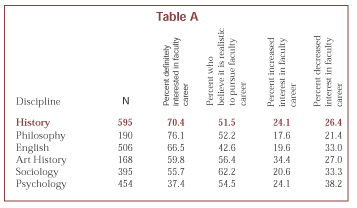 Although history students want to become faculty members, many recognize that their goal may not be realized. When asked if each of these career options was realistic, 51.5 percent said a faculty career was "definitely" realistic and 42.6 percent selected "possibly." Again, a very small proportion see this as unrealistic with only 5.8 percent selecting "not at all."
Although history students want to become faculty members, many recognize that their goal may not be realized. When asked if each of these career options was realistic, 51.5 percent said a faculty career was "definitely" realistic and 42.6 percent selected "possibly." Again, a very small proportion see this as unrealistic with only 5.8 percent selecting "not at all."
Information from the 1997 cohort of history PhDs (Table B) demonstrates that even this more cautious estimation of career plans may still be overly optimistic. The most recent data from the Survey of Earned Doctorates (completed by doctoral students as they file their dissertations) shows that only 45 percent have secured positions, and of those only three-fourths (or 33 percent of all doctoral recipients) report that teaching is their primary occupation. Surely many still seeking employment (another 33 percent) will find positions, and some of those will be college teaching positions. Nevertheless, in today's job market it is not likely that all of those who want to have faculty jobs or even those who believe that they will get such jobs will have their dreams realized.
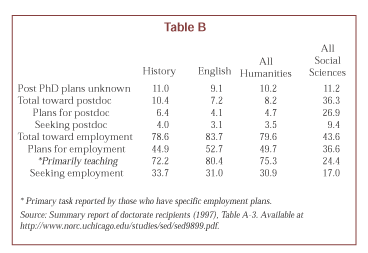
History students obviously are deeply committed to faculty careers. What is the appeal of these careers? The aspect of faculty life that most strongly draws students towards academic life is a love of teaching. 88.4 percent of those interested in pursuing a faculty career indicated that their enjoyment of teaching is a key factor. The next most popular considerations (of 18 listed) are enjoyment of life on a college campus (81.9 percent), love of research (76.7 percent), enjoyment of the faculty lifestyle (64.5 percent), and the encouragement of faculty (51.1 percent). These are similar to those cited in other disciplines.
To be sure, history students (again, mirroring their counterparts in other disciplines) also see aspects of the faculty career that give them pause. These are the tenure process (47.3 percent say this makes them less interested in a faculty career), the job market (46.9 percent), being geographically constrained (31.3 percent), and the high workload of faculty (26.1 percent). In other words, the conditions of work mitigate the enthusiasm students have for academic life. Notably, salaries are not an issue for history students: they are least likely of students in any field to rank salaries as a deterring factor.
A final item, being unable to lead a balanced life and raise a family, deserves special mention. Slightly more than a quarter of the history students (27.4 percent) said that ability to lead a balanced life made them less interested in being a faculty member, and a third (36.9 percent) said that it made them more interested. Those who said it made them less interested rated the ability to lead a balanced life as difficult to do (a mean of 2.14 on a five-point scale), whereas those who found this an attractive feature of academia found it very possible (mean of 4.44). Perceptions and beliefs about the nature of faculty work and the academic lifestyle clearly influence student plans. Furthermore, there is considerable variation in these perceptions. However, there are not significant gender differences in these items.
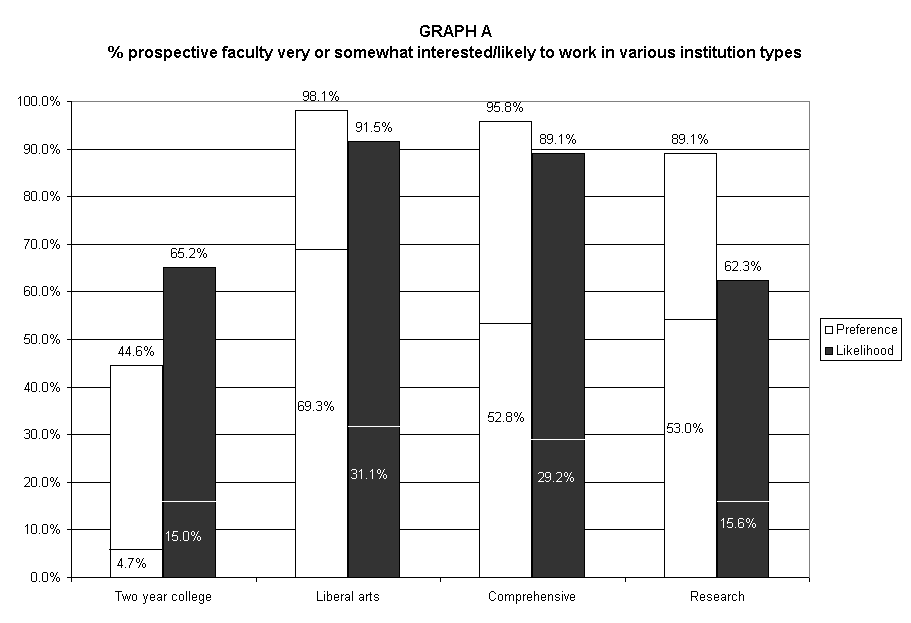
Where do prospective faculty want to work? Here again both the overall enthusiasm and the measure of realism that history students feel is visible. Graph A shows the reported preference for and interest in (measured on a three-point scale: very much, somewhat, and not at all) working at four different kinds of colleges and universities. History students are most interested in working at liberal arts colleges. This is followed by equal levels of enthusiasm for working at research universities and comprehensive universities (four year universities with undergraduates and master's students). Two year colleges are by far the least appealing type of institutions. Focusing on institution type reveals that history students see their specific desires as relatively unrealistic. Although nearly 70 percent of the students want very much to work at a liberal arts college, only 31 percent see this as a likely outcome. This same gap between desire and perceived reality holds across institution types, with a predictable shift—it is more realistic than desired—for two year colleges. By comparison, federal survey data on all of the history PhDs currently working, shows that 64.4 percent are working in college and universities and 6.4 percent are working in two-year colleges (see Humanities Doctorates in the United States 1995 Profile, p. 37).
Preparation for Faculty Careers
Given that such a high proportion of students are interested in faculty careers, we wanted to understand how well they are prepared to conduct the various aspects of faculty work. We thus queried students about tasks and roles related to research, teaching, and service.
How prepared are history students to teach? One might expect their skills to be well developed, especially relative to their colleagues in other fields because historians are relatively well practiced in teaching. Teaching is one of the primary mechanisms for funding history graduate students (unlike many other disciplines, particularly the sciences). Normatively, it is part of the history graduate student experience, although only a third (36.4 percent) describe TAing as a program requirement. Moreover, in response to questions about access to professional development opportunities, nearly two-thirds can take progressively more responsible roles in teaching (59.6 percent) and have access to a course on teaching in the discipline (62.7 percent). Finally, recall that a love of teaching is nearly unanimously cited as a motivator for entering a faculty career.
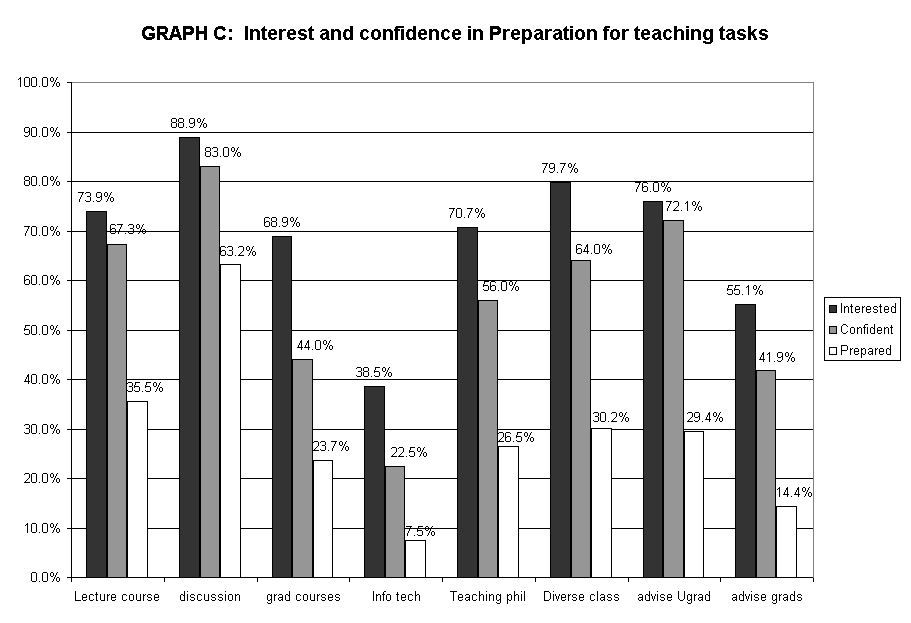
In Graph C we see rather striking gaps between the teaching tasks that students are interested in and those that their programs have prepared them to do. Moreover, nearly every aspect of teaching is compelling. Only incorporating information technology into the classroom is of relatively little interest. The commitment history graduate students have to teaching is also highlighted by comparison to the other fields, where there are much lower levels of interest in many aspects of teaching.
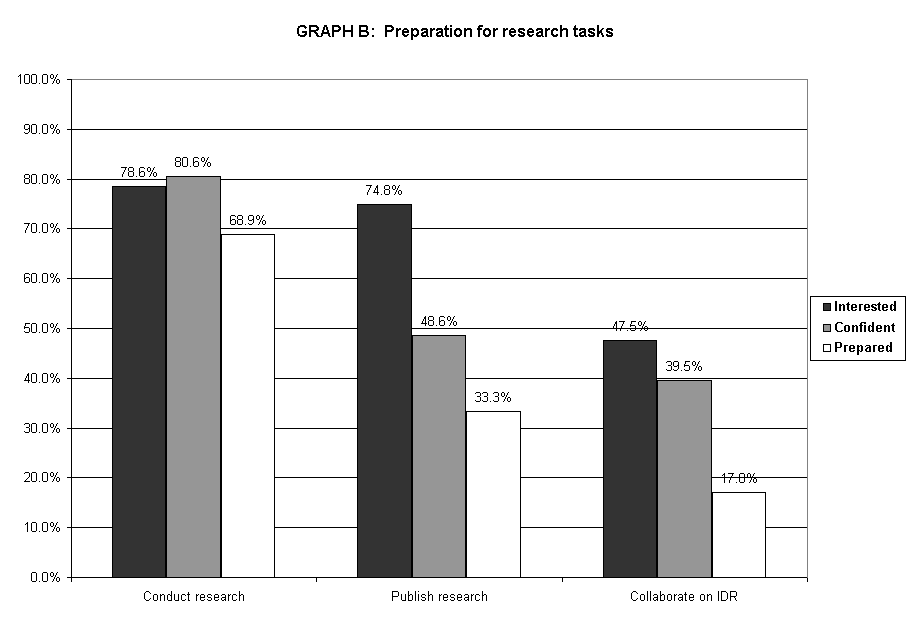
The emphasis of the PhD is research training, so we surmised that students would be, if anything, prepared to conduct and disseminate research. We found, consistently across the disciplines, that students believed themselves to be well prepared to conduct research, but less well prepared to share their findings. As shown Graph B, most of the students reported being interested in and prepared by their program to conduct research. Commensurately, 90.8 percent report the opportunity to present research at a meeting, and 70.6 percent have done so. Furthermore, 76.4 percent of those for whom that opportunity is available have been encouraged to avail themselves of it.
However, only a third (33.5 percent) of the students reported being prepared by their program to publish research (even though three-quarters were interested in doing so). This finding is slightly below the average of all 11 disciplines in the study, where 42.9 percent reported being prepared to publish. Among the other humanities and social science fields, psychology students believe themselves to be most prepared (62.9 percent) and philosophy students the least (24.1 percent); the other three fields are similar to history.
Looking More Broadly
Given that academic careers cannot be taken for granted at the conclusion of a history PhD, it is important to consider whether history doctoral students are exposed to a range of career options.
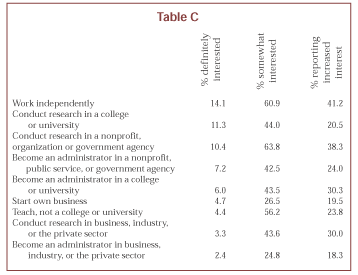 What career paths appeal to doctoral students in history? Given that nothing is as compelling as a faculty career, history students are most interested in working independently (e.g., consultant or writer) (14.1 percent were definitely interested), conducting research in a college setting (11.3 percent), and conducting research in a non-profit or government agency (10.4 percent) (Table C). Teaching in a non-college setting was only the sixth most popular option, after becoming a university administrator and starting one's own business. This seems particularly surprising given the commitment to teaching evidenced by these students. Another telling indicator of the students' nonacademic career interests is the data about which careers seem to have increased in attractiveness as a result of graduate study. These are: working independently (41.3 percent), research in nonprofits (38.3 percent), university administration (30.3 percent) and research in for-profit sector (30.1 percent). Again, only 23.8 percent become more interested in non-college teaching.
What career paths appeal to doctoral students in history? Given that nothing is as compelling as a faculty career, history students are most interested in working independently (e.g., consultant or writer) (14.1 percent were definitely interested), conducting research in a college setting (11.3 percent), and conducting research in a non-profit or government agency (10.4 percent) (Table C). Teaching in a non-college setting was only the sixth most popular option, after becoming a university administrator and starting one's own business. This seems particularly surprising given the commitment to teaching evidenced by these students. Another telling indicator of the students' nonacademic career interests is the data about which careers seem to have increased in attractiveness as a result of graduate study. These are: working independently (41.3 percent), research in nonprofits (38.3 percent), university administration (30.3 percent) and research in for-profit sector (30.1 percent). Again, only 23.8 percent become more interested in non-college teaching.
The situation in history mimics that of other social science and humanities disciplines, but the gap between the interest in faculty careers and other paths is greater than in any other discipline we studied, with the exception of philosophy.
Are history students revealing preferences drawn from having explored and considered other options, or do these preferences reveal ignorance of other possibilities? There are some data in the survey that suggest that the first explanation may be the correct one. As described earlier, we provided those students who imagined ever being a faculty member a list of factors that influence the desire to be a faculty member. We asked them to rate (on a five-point scale) their opinion of each item, and its impact on their desire to be a professor. One factor was their exposure to other careers (know a lot vs. know very little) and the other was the appeal of other careers (very appealing vs. not at all appealing). Relative to their counterparts in other disciplines, historians profess to know a great deal about other careers. The mean level of knowledge about other careers is second only to the mean rating by art historians. Similarly, they describe themselves as uninterested in other careers. Here the mean level of interest is lower than in any discipline except philosophy. Furthermore, many historians say that their exposure to and the appeal of other careers makes them more interested in being a faculty member (43.4 percent and 39.1 percent respectively). These data say, in effect, that history students believe that they have surveyed the terrain of other available jobs and in light of that knowledge, would prefer to be faculty members.
Considered as a whole, these data reinforce the data that indicated the strong levels of interest in faculty careers on the part of history students.
Departmental Responses
What kinds of programmatic initiatives are departments already taking to address the kinds of issues raised in this study?
History departments, at least relative to other disciplines, seem to be doing some good work in helping students find jobs. Most history programs appear to offer help to students who are on the academic job market. Three-quarters of the students (73.2 percent) reported that an academic job search workshop was available, although we did not do an independent check to determine if that was in fact the case. Only English students reported the availability of such a workshop more frequently (82.0 percent), with philosophy coming in third (63.5 percent). In other fields of study such an opportunity was reportedly less widely available. This suggests that these three disciplines, arguably ones most plagued by a severe gap between the number of academic jobs and job seekers, are responding by trying to equip students with better job search skills.
And do programs help students to find nonacademic careers? Slightly fewer than half of the history students (44.4 percent) had a workshop on nonacademic careers available to them. This was similar to the other disciplines. More English students report that these workshops are available (50.5 percent); and history is tied with sociology. Only a quarter of the students in psychology and philosophy identified such an opportunity.
Encouragingly, most of history students agree (72.8 percent) that their advisor would support any career path they would choose. In all of the disciplines, the proportion is very similar. Unfortunately, students recognize that their advisors may not be equipped to help them find non-academic jobs. A far lower proportion, 44.3 percent, agreed that their advisor provided information about possible career paths to them.
Implications
In summary, history students are saying that they are primarily interested in becoming faculty members, even though they recognize that this interest may be unrealistic, or may mean working at an institution that is of little appeal, such as a community college. History doctoral programs are, if the reports of students are accurate, providing information about nonacademic career options. This information does not seem to spark interest, however, in nonacademic career opportunities. Moreover, the data suggest that students are primarily prepared to conduct the work that faces them as graduate students, rather than preparing them for the careers that they will face upon graduation, whether within academia or outside of it. Of course this situation is not unique to history, but rather is one facing the preparation of graduate students more generally.
The fact remains that there are fewer faculty positions than there are history PhDs and there is no indication that this imbalance will change. In light of that, several policy responses seem plausible: increase the number of other career options, increase the appeal of those to history students, or decrease the number of doctoral students. It may, of course, be possible to embark on several of these courses at the same time. Engaging in a vigorous debate about how to fruitfully address this mismatch between students' interests and desires and the labor market, seems imperative.
Chris M. Golde conducted this research at the University of Wisconsin-Madison as an Assistant Professor of Educational Administration and a research scientist at the Wisconsin Center for Education Research in Madison. She is now a Senior Scholar at the Carnegie Foundation for the Advancement of Teaching.
Tags: Career Diversity for Historians
Comment
Please read our commenting and letters policy before submitting.






